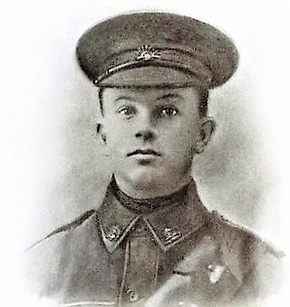
SAXON, Bertie Henry
| Service Number: | 2708 |
|---|---|
| Enlisted: | 10 May 1916, Melbourne, Victoria |
| Last Rank: | Private |
| Last Unit: | 2nd Pioneer Battalion |
| Born: | Euroa, Victoria, 8 July 1891 |
| Home Town: | Violet Town, Strathbogie, Victoria |
| Schooling: | Euroa State School |
| Occupation: | Compositor/Printer |
| Died: | Died of wounds, Montbrehain, France, 6 October 1918, aged 27 years |
| Cemetery: |
Tincourt New British Cemetery |
| Memorials: | Australian War Memorial Roll of Honour, Euroa Fallen of Euroa District Honour Roll, Euroa School No 1706 Roll of Honour, Euroa St. Andrew's Presbyterian Church Honour Roll WW1, Euroa Telegraph Park, Euroa War Memorial, Violet Town Honour Roll WW1 |
World War 1 Service
| 10 May 1916: | Enlisted AIF WW1, Private, 2708, Melbourne, Victoria | |
|---|---|---|
| 18 Sep 1916: | Embarked AIF WW1, Private, 2708, 2nd Pioneer Battalion, Embarked on HMAT 'A10' Karroo from Melbourne on 18th September 1916, disembarked at Plymouth, England on 15th November 1916. Proceeded to France by Princess Victoria from Folkestone on 31st December 1916. | |
| 5 Oct 1918: | Wounded AIF WW1, Private, 2708, 2nd Pioneer Battalion, Died from penetrating’ shrapnel wound to his neck |
Help us honour Bertie Henry Saxon's service by contributing information, stories, and images so that they can be preserved for future generations.
Add my storyBiography
SAXON Bertie Henry 2708 PTE
2nd Pioneer Battalion
1891-1918
When Bertie first tried to enlist he was knocked back because of his height - he was 5ft 2 ins - but he persisted and was successful on 10 May 1916 when he was accepted into the 2nd Pioneer Battalion. He had been working as a compositor at the Violet Town Sentinel office in Cowslip Street with his older brother Tom as editor. When Tom enlisted in April 1915 Mr Ford from the Euroa Advertiser acted as manager.
Bertie embarked from Melbourne in September 1916 on board HMAT Karroo; his destination was Plymouth where he arrived in November. Shortly afterwards, he was sent overseas to Etaples in France where, due to an outbreak of mumps he was confined to a segregation camp. He re-joined his battalion in February 1917.
For most of 1917 the 2nd Battalion were employed in horrendous conditions around Ypres. The winter of 1916/17 had been particularly cold and wet. On 20 October Bertie was sent to a rest camp for a week after which he returned to duty. The following July 1918 he had leave in England, re-joining his unit at the end of the month, while it was engaged in stopping the German Spring offensive.
Three months later in October, Bertie was wounded in action with a gun-shot wound to his neck; he was admitted to a casualty clearing station where he died the next day. The attack in which Bert was wounded was to be the last in which Australian troops took part. Montbrehain village fell to the allies and with that the Hindenburg Line was broken. The American army took over to give the Australians a rest; they had been fighting for over six months without a break.
Bert’s last letter was written on Saturday 1 August 1918 – perhaps with a sense of tired anticipation that the war may end soon - ‘just a line to let you know that I am well and in pretty good health . . . doing odd jobs on roads . . . very little time to write . . . things are going pretty well over here . . . the Hun is starting to put up a bit of a stand but the boys keep moving them on . . . kindly remember me to our Euroa or Violet Town friends’ enquiries.’
Bert is buried at Tincourt New British Cemetery, East of Peronne, Plot 6, Row D, Grave No 18
In 1921 Bert’s mother wrote to the War Graves Commission requesting that an inscription in memory of Bert’s younger brother Joe who was killed in 1916, be also engraved on Bert’s headstone.
Service Medals: Memorial Plaque and Scroll British War Medal Victory Medal
Memorials: Avenue of Honour Euroa
Main Honour Board, Memorial Hall, Violet Town
Euroa State School
Copper plaque affixed to external wall of Memorial Hall
Euroa Town Band Honour Roll
St Andrew’s Presbyterian Church, Euroa
Tree no 38 was planted in 1917 by F Peacock
In 2013 a Ceratonia siliqua - Carob Tree - was planted by Stuart Saxon
© 2016 Sheila Burnell











